 Waugh elevates missing person procedurals to a new level. 
Reading mid-century crime and adventure novels has been a great journey for us. We can imagine those who've already read them smiling (or smirking) as we discuss the books as revelations. “These pulp guys. *eye roll* ’Bout seventy years late with their stunning insights.” But that's the way it goes—you have start sometime. Over the years we've gone from novice to slightly-less-novice in this realm.
We say all that because, though Hillary Waugh is a well-known novelist, up to this week we'd read only one of his books—1960's The Girl Who Cried Wolf. It's a personality-driven, occasionally cute tale, about a tough P.I. and the collegiate client who has a massive crush on him. The book is pretty much a total success. There was no logical reason for us think that single effort defined Waugh's style, but experience has shown that a good novel tends to sits in the sweet spot of an author, and they hit those notes again and again.
Imagine our surprise, then, when we read 1954's Last Seen Wearing and discovered that it's a stark police procedural allegedly inspired by the true 1946 disappearance of 18-year-old Bennington College student Paula Jean Welden. What Waugh produces is basically impossible to put down. If you like police procedurals, read this one. Waugh wows. Also wow is the cover art on the 1960 Great Pan edition. Uncredited though.
 Relax, honey. They must be from that boat with the skull flag. I bet they're spring breakers on a booze cruise. 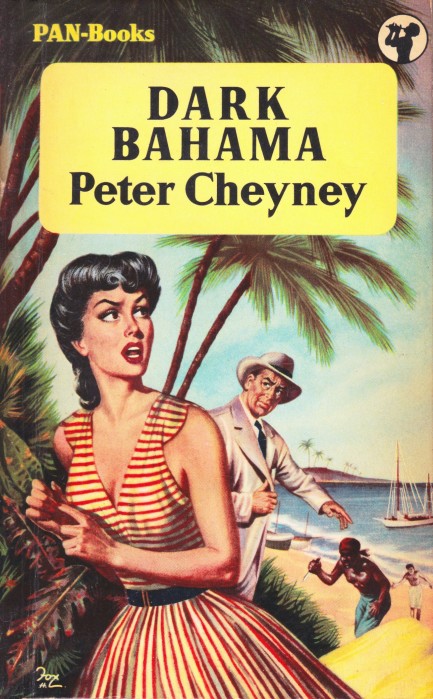
The 1960 Fontana edition of Peter Cheyney's Dark Bahama, with its unlucky man being mauled by a shark, is one of the craziest mid-century paperback covers you'll see. By contrast, the earlier 1957 edition above from Pan Books goes a bit more traditional. It was painted by Henry Fox, easily recognizable thanks to his unique signature at lower left. The book is unique too. Feel free to read the earlier write-up to find out how.
 Help! Somebody! Get my employment agency on the line and tell them I need a new job! 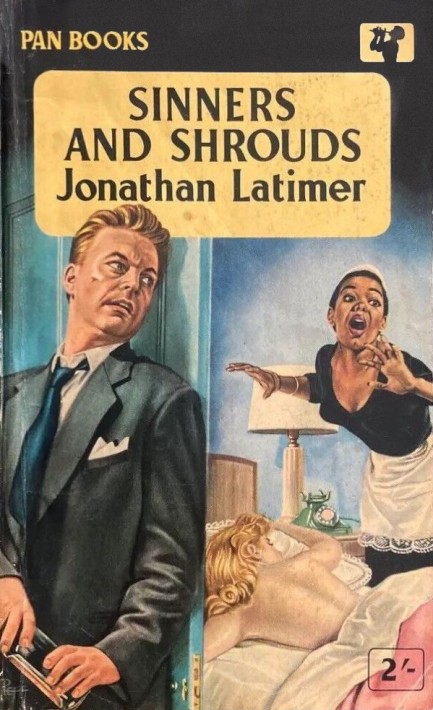
Her contract says no windows, laundry, or corpses, so it looks like there's going to be an opening for a new maid. Jonathan's Latimer's Sinners and Shrouds, the Pan Books version of which you see above with art from Samuel Peffer, is a find-the-real-killer novel in which the main character, ace reporter Sam Clay, wakes up in bed with a murdered blonde and needs to figure out how that happened before the police nab him. He's blacked out the entire previous night thanks to some serious imbibing and, though he has few clues, eventually learns that the murder has to do with an enormous sum of money and has roots in the past. In the hands of many authors this would be a standard tale, but Latimer is an upper tier craftsman, and everything from the dialogue to the unusual mystery at the center of the book are a cut above. We won't say it approaches his best—it was his second-to-last novel—but it's still Latimer and that means it's worth a read.
 In battle of bullets versus brawn balance turns out to be the deciding factor. 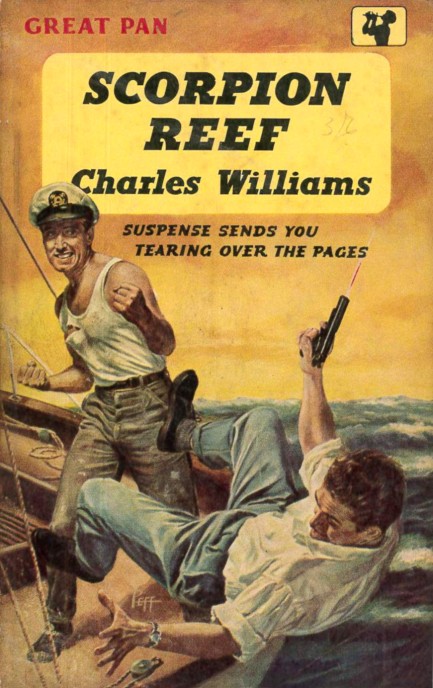
We mentioned that Charles Williams' 1955 novel Gulf Coast Girl was originally published as Scorpion Reef. Above is a look at the cover Great Pan produced for its 1958 edition. This was a typically excellent Williams effort, as we noted earlier.
 Too bad life doesn't have a rewind button—you could go back to when you wouldn't let me seduce the information out of you. 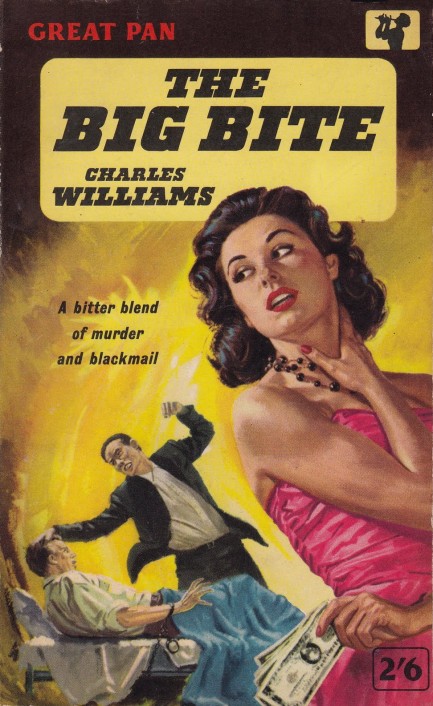
This is a fantastic piece of art for The Big Bite by Charles Williams. We'd be tempted to say frequent Pan Books illustrator Sam Peffer painted it, but he almost always signed his work in a place where it was not easily cropped or covered, the clever boy. Therefore we've seen only a few confirmed fronts by him where his signature was not present. Well, whoever was responsible for the art, we love this scene. You have a man recieving a severe beatdown as the femme fatale stands in the foreground barely interested. They do bore easily. In addition to the excellent art, this was an entertaining tale. We talked about it last year, and you can see what we thought at this link. It was originaly published in 1956, with this edition coming in 1960.
 Think your marriage is difficult? Think again. 
Patricia Highsmith is here to tell you that no matter your perceived problems with your spouse, they're actually a traipse down a flowered path, because Vic and Melinda Van Allen, the two main characters of her 1957 drama Deep Water—they have marital problems. Melinda is a serial cheater, and Vic has become so numb over the years that he can't even be bothered to care. Melinda is so brazen she brings her lovers to the house to stay overnight and shows up with them at neighborhood parties. She even neglects and ignores her young daughter. In a fit of pique one night Vic claims to an acquaintance that he killed one of Melinda's ex-lovers—who in reality had simply drifted away—and the reaction he gets makes him feel excellent. When he murders Melinda's next lover for real, and gets away with it, he feels still better. So he murders her next lover...
Patricia Highsmith was the high mistress of sociopathic characters, and Vic Van Allen, coming a couple of years after her famed psycho Tom Ripley, is an amazing creation. He's kind, urbane, low key, and horribly mistreated—all of which makes him a pressure cooker ready to explode. Deep Water is told entirely from his point of view, and its highly interiorized narrative makes you really feel for the guy—even after he starts killing people. The key to dragging forth the reader's sympathy is Highsmith's portrayal of Melinda, who tortures Vic day in and day out, destroying his peace of mind, his reputation, and his masculinity. This is a highly recommendable book, and if you can get the 1961 Pan edition you see here with Sam Peffer cover art, you'll be that much the happier for it. 
 Looks like neither of us values tidiness or organization, so that's cool. 
Ben Ostrick, who signed his work J. Oval, painted this 1963 Pan Books cover for Sloan Wilson's 1960 novel A Sense of Values. Ostrick was an amazing artist, with a colorful and harmonious style that Pan used to good effect on scores of covers. We wrote way back that he was British, but a few online sources say he was actually Australian. We'll dig into that at some point and see if we can figure it out. In the meantime, we have two small collections of his work, here and here. You should have a look.
Edit: We got an e-mail from a family member of Mr. Ostrick, who said, "I read that you weren’t sure if he was English or Australian. He is English and moved to Australia when my Mom was a teenager. They lived alone together until he died."
So there you go. As we always say, the answers tend to come over time. Thank you for writing in with that info. That was extremely kind.
 Upfield's franchise character is never quite fleshed out. 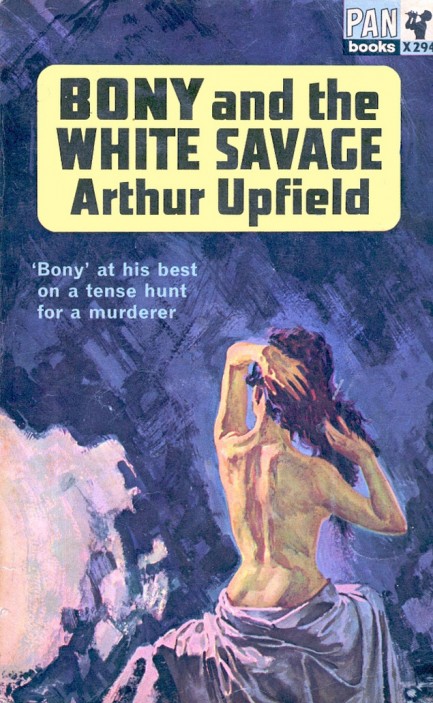
Bony and the White Savage, for which you see a Pan Books cover above, has as its central character a half aborigine detective named Napoleon Bonaparte—Bony for short. The idea of this person made us think immediately of Ed Lacy's creation Toussaint Marcus Moore, considered to be the first African American detective in literature. But Upfield may have been first to create a black detective of any nationality—that is if we accept being half black ethnically as being fully black culturally. It's certainly that way in the U.S., as we've talked about before. Upfield created his Bony character and first published him way back in 1929, almost thirty years before Lacy, and the above installment of what was a long running series of Bony novels is from 1964 and sees the hero on the trail of a rapist and overall hellion who's holed up somewhere in the wild crags of the southwestern Australian coast.
Good premise, but in short, our hopes that this book would be something akin to Ed Lacy were misplaced. The way it's written, Bony being half aborigine is wasted—which is to say it impacts nothing and nobody mentions it. That approach might be commendable from a purely fictional perspective, but is it realistic? We've lived outside the U.S. for a long time, so we understand—trust us, we understand—that compared to the rest of the world Americans tend to overdo things. Like, everything. So Upfield would definitely be more subtle than Ed Lacy, who made the color of his Toussaint character central, but Upfield veers pretty far in the other direction, presenting a colorblind outback we know for a fact doesn't exist today. Was it colorblind back then? We doubt it, but Australian aborigines have recessive genes for blonde hair and blue eyes, so Bony might have fit in physically a lot better than we imagine.
But let's set that aside, because this is fiction, and a writer can do anything he or she wants. At least that's what we think. They're required to pull it off, though. Purely in terms of the plot, we had pretty high expectations here and they went unmet. Despite the exotic setting, interesting set-up, the unusual hero, and the fearsome antagonist, Bony and the White Savage isn't special. And we were really looking forward to reading an entire series of Down Under adventures, with all its local quirks and idiosyncrasies. But you know us by now. We're tenacious. This particular book, which was the only one available to us, is number twenty-six in the Bonaparte series. We're going to try again. We suspect that the qualities we anticipated are in the first book, The Barrakee Mystery, in which this Bony person must be more fully fleshed out. So we'll read that. If we can find it.
 The deeper you go into this casino the wilder it gets. 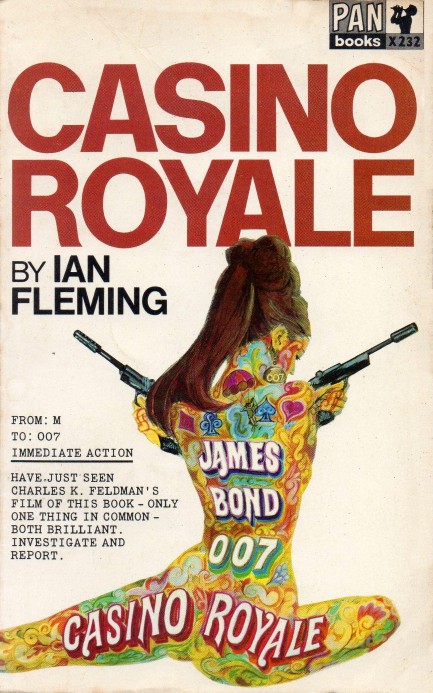 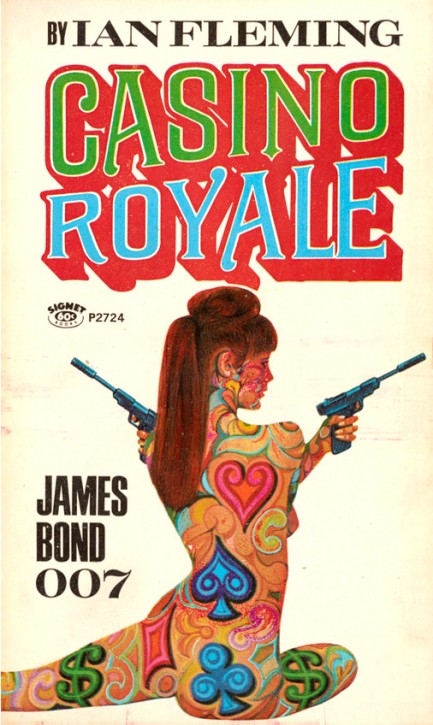
Today we're circling back to James Bond—as we do every so often—to highlight these movie tie-in editions of Ian Fleming's Casino Royale. The movie these are tied into is not the 1963 original with Sean Connery, but the 1967 screwball version with David Niven as Bond and Woody Allen as Bond's nephew Jimmy Bond. If you haven't seen it, just know that it was terribly reviewed, with Time magazine calling it an “an incoherent and vulgar vaudeville.” These covers are derived from the Robert McGinnis Casino Royale movie poster, which is an all-time classic. McGinnis created two versions of the poster—one with text and one without, with the painted patterns on the female figure varying slightly. You see both of those below.
The paperback was published by both Great Pan and Signet, and the cover art was different for the two versions. The Great Pan version at top is McGinnis's unaltered work, but the Signet version just above was painted by an imitator, we're almost certain. We'd hoped to answer this for sure by visiting one of the numerous Bond blogs out there, but none of them have really discussed the difference between the 1967 paperback covers. That leaves it up to us, so we're going to say definitively that the Great Pan version was not painted by McGinnis. Whoever the artist was, they did a nice job channeling the original piece, even if the execution is at a much simpler level.
Moving back to the posters, if you scroll down you'll see that we decided to focus on the details of the textless version to give you a close look at McGinnis's detailed work. The deeper you go the more you see—dice, poker chips, glittery earrings, actor portraits, and more. If you had a huge lithograph of this on your wall and a tab of acid on your tongue, an entire weekend would slip past before you moved again. This is possibly the best work from a paperback and movie artist considered to be a grandmaster, one the greatest ever to put brush to canvas. If anyone out there can tell us for sure who painted the Signet paperback—or whether it is indeed McGinnis—feel free to contact us.  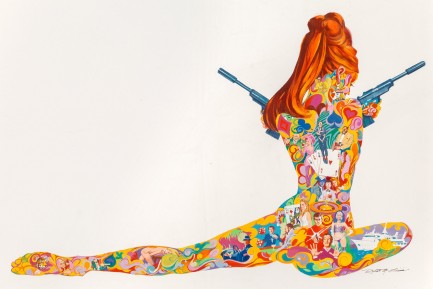 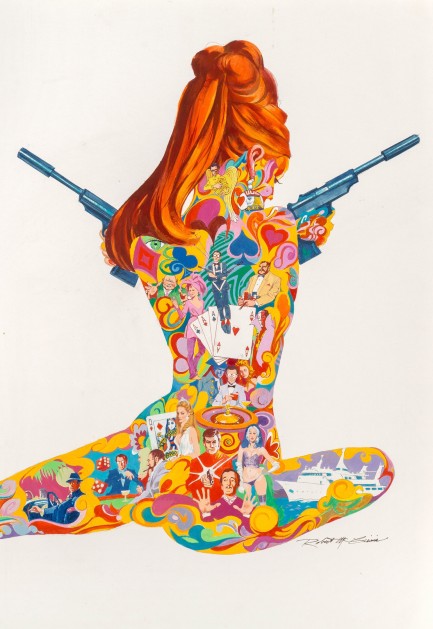 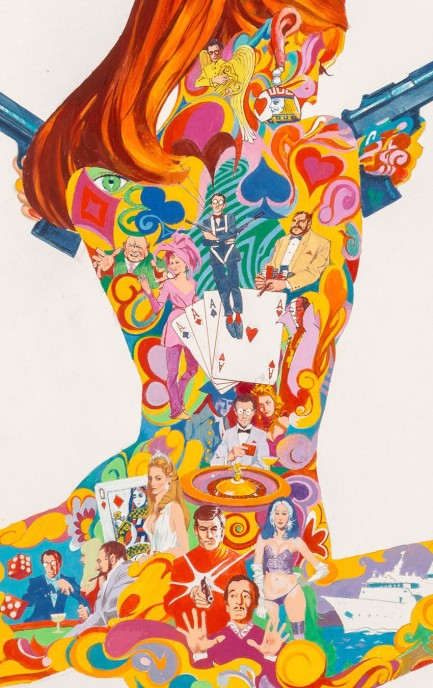
 He'll make you love him even if it kills you. 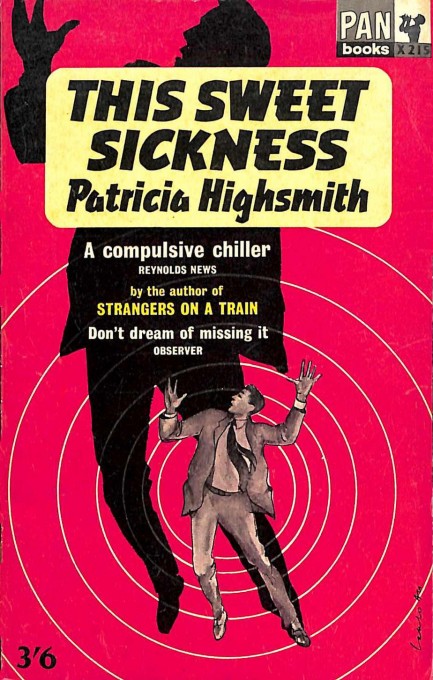
Patricia Highsmith's reputation demands that you read any book of hers you find, so when we ran across This Sweet Sickness we knew it would be good. Originally published in 1960 with this paperback coming from British publisher Great Pan in 1963, she tells the story of another troubled man à la her famous Tom Ripley novels. Here we have David Kelsey, in love with a woman who, inconveniently, is married. No problem, though, because obstacles mean nothing. He's determined to win his prospective love's affections, ignoring the fact that she's both unavailable and uninterested.
The book is told from the perspective of this dangerously deluded man, and his mental dissonance, deftly written by Highsmith, is cringe inducing. In Kelsey's head, everything is proof his love is returned. When the woman he desires is kind, it encourages him. When she's resistant, he assumes she isn't acting of her own accord, but instead is being pressured by her husband. There's nothing she can do—literally nothing—to dissuade Kelsey from the idea that his love for a woman obligates her to love him back. It all leads pretty much where you expect—to conflict, terror, death, and the high, lonely ledge of insanity.
It's fascinating to us that the U.S. born Highsmith was unappreciated in her own country, despite her breakthrough at age twenty-nine with Strangers on a Train. Well, considering she spent her life writing novels while residing mainly in France and Switzerland, we doubt she suffered much from the neglect. She's well remembered as an author now, though less so as a person, since she had views that were eyebrow raising even in the context of her era. But This Sweet Sickness is an interesting and relevant book, and we highly recommend it.

|
 |

The headlines that mattered yesteryear.
1945—Churchill Given the Sack
In spite of admiring Winston Churchill as a great wartime leader, Britons elect
Clement Attlee the nation's new prime minister in a sweeping victory for the Labour Party over the Conservatives. 1952—Evita Peron Dies
Eva Duarte de Peron, aka Evita, wife of the president of the Argentine Republic, dies from cancer at age 33. Evita had brought the working classes into a position of political power never witnessed before, but was hated by the nation's powerful military class. She is lain to rest in Milan, Italy in a secret grave under a nun's name, but is eventually returned to Argentina for reburial beside her husband in 1974. 1943—Mussolini Calls It Quits
Italian dictator Benito Mussolini steps down as head of the armed forces and the government. It soon becomes clear that Il Duce did not relinquish power voluntarily, but was forced to resign after former Fascist colleagues turned against him. He is later installed by Germany as leader of the Italian Social Republic in the north of the country, but is killed by partisans in 1945. 1915—Ship Capsizes on Lake Michigan
During an outing arranged by Western Electric Co. for its employees and their families, the passenger ship Eastland capsizes in Lake Michigan due to unequal weight distribution. 844 people die, including all the members of 22 different families. 1980—Peter Sellers Dies
British movie star Peter Sellers, whose roles in Dr. Strangelove, Being There and the Pink Panther films established him as the greatest comedic actor of his generation, dies of a heart attack at age fifty-four.
|

|
|

It's easy. We have an uploader that makes it a snap. Use it to submit your art, text, header, and subhead. Your post can be funny, serious, or anything in between, as long as it's vintage pulp. You'll get a byline and experience the fleeting pride of free authorship. We'll edit your post for typos, but the rest is up to you. Click here to give us your best shot.

|
|































































































